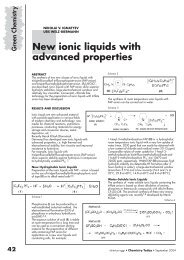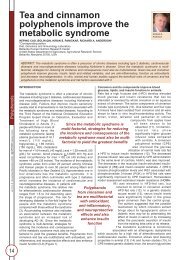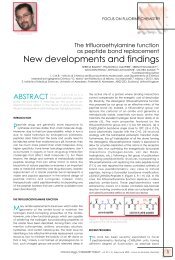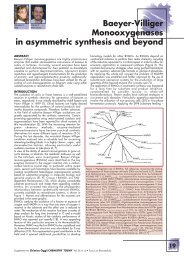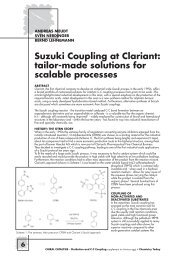Mastering ozonolysis: production from laboratory to ton scale in ...
Mastering ozonolysis: production from laboratory to ton scale in ...
Mastering ozonolysis: production from laboratory to ton scale in ...
Create successful ePaper yourself
Turn your PDF publications into a flip-book with our unique Google optimized e-Paper software.
56<br />
FLOW CHEMISTRY<br />
<strong>Master<strong>in</strong>g</strong> <strong>ozonolysis</strong>:<br />
<strong>production</strong> <strong>from</strong> <strong>labora<strong>to</strong>ry</strong><br />
<strong>to</strong> <strong>to</strong>n <strong>scale</strong> <strong>in</strong> cont<strong>in</strong>uous flow<br />
MARKUS NOBIS, DOMINIQUE M. ROBERGE<br />
Lonza AG, Visp, 3930, Switzerland<br />
KEYWORDS: Ozone, Ozonolysis, Oxidation, Scale-up, Microreac<strong>to</strong>r<br />
Technology, Microreac<strong>to</strong>rs, Cont<strong>in</strong>uous Flow Processes,<br />
Green Chemistry, Susta<strong>in</strong>ability<br />
ABSTRACT: In most cases, <strong>ozonolysis</strong> is more susta<strong>in</strong>able and cost<br />
effective for the oxidative treatment of organic unsaturated<br />
compounds than other oxidation technologies. To enable the<br />
scalability of this challeng<strong>in</strong>g gas-liquid oxidation process, Lonza<br />
has developed a novel approach that comb<strong>in</strong>es microreac<strong>to</strong>rs,<br />
a bench-<strong>scale</strong> reac<strong>to</strong>r, and a large <strong>scale</strong> <strong>production</strong> reac<strong>to</strong>r.<br />
The approach also <strong>in</strong>cludes <strong>labora<strong>to</strong>ry</strong> feasibility studies<br />
and technical transfer - with hazard evaluations and safety<br />
assessments - <strong>to</strong> successful large <strong>scale</strong> manufactur<strong>in</strong>g.<br />
INTRODUCTION<br />
Ozone is a colourless gas that has an oxidation potential similar <strong>to</strong><br />
chlor<strong>in</strong>e. Ozone is characterized and identified by the very<br />
characteristic smell of fresh, spr<strong>in</strong>g ra<strong>in</strong> when diluted. Based on its<br />
high reactivity (1, 2), the gas is a well-known oxidation agent for<br />
various applications, <strong>from</strong> waste water treatment (3) <strong>to</strong> potable<br />
water purification (4). In organic synthesis, ozone is well known for<br />
the cleavage of olef<strong>in</strong>ic double bonds (unsaturated compounds)<br />
and oxidation (5, 6, 8) performed at extremely low temperatures (<strong>in</strong><br />
general cryogenic). It is ma<strong>in</strong>ly known for generat<strong>in</strong>g high energetic,<br />
unstable reaction products called ozonides (decomposition energy:<br />
200-400 kJ/mol), which tend <strong>to</strong> decompose under sudden heat<br />
evolution and have <strong>to</strong> be treated directly under oxidative or<br />
reductive conditions. Reactions with ozone are characterized by<br />
high a<strong>to</strong>m efficiency of the oxidiz<strong>in</strong>g reagent where 66 mol% of the<br />
molecule is directly used <strong>in</strong> the reaction compared <strong>to</strong> other<br />
oxidation systems. Moreover, ozone is an environmentally friendly<br />
reagent that forms oxygen as direct side product <strong>from</strong> the<br />
<strong>ozonolysis</strong>. It is therefore a green and susta<strong>in</strong>able oxidation agent.<br />
Based on the fact that it generates carbonyl compounds, <strong>ozonolysis</strong><br />
can be described as a technology platform that allows access <strong>to</strong> a<br />
broad range of oxygen-conta<strong>in</strong><strong>in</strong>g substances (Figure 1).<br />
CURRENT STATE<br />
In <strong>in</strong>dustrial chemical applications, the use of <strong>ozonolysis</strong> has<br />
come and gone <strong>in</strong> waves due <strong>to</strong> the difficulty <strong>in</strong> handl<strong>in</strong>g ozone;<br />
most <strong>in</strong>dustrial scientists <strong>to</strong>day have experience with ozone<br />
through their university studies. Nevertheless, other s<strong>to</strong>ichiometric<br />
methods for double bond oxidation based on heavy metals –<br />
chimica oggi/Chemistry Today - vol 29 n 1 January/February 2011<br />
Markus Nobis<br />
such as the well known permanganese salts, or chromic acid (6)<br />
– are preferred over <strong>ozonolysis</strong> due <strong>to</strong> their ease of<br />
implementation. In addition <strong>to</strong> be<strong>in</strong>g a<strong>to</strong>m <strong>in</strong>efficient, these salts<br />
pose severe challenge <strong>in</strong> cGMP applications. For example, <strong>in</strong><br />
cosmetic <strong>in</strong>gredients, residual traces of metal are <strong>in</strong><strong>to</strong>lerable and<br />
require complex purification methods (15). Those issues are<br />
overcome by the application of ozone <strong>in</strong> cont<strong>in</strong>uous flow/semibatch<br />
<strong>production</strong>. The subsequent eco-friendly post-treatment of<br />
the ozonide creates the desired product.<br />
Ozonolysis rema<strong>in</strong>s hampered by critical concerns over safety<br />
and technical implementation. Those issues <strong>in</strong>clude:<br />
1. The high-energy potential of the ozonides, <strong>in</strong> the worst<br />
case, lead<strong>in</strong>g <strong>to</strong> explosions.<br />
2. Challeng<strong>in</strong>g gas-liquid mass transfer limited process with<br />
high exothermy.<br />
3. Operation of flammable organic solvents <strong>in</strong> the presence<br />
of air/oxygen. Ozone is up <strong>to</strong> 15 wt% diluted <strong>in</strong> these gases<br />
and leads <strong>to</strong> a very high gas-liquid volume ratio for<br />
s<strong>to</strong>ichiometric operation. Moreover, the manner <strong>in</strong> which<br />
the flash po<strong>in</strong>t of organic solvents is affected by ozone is<br />
difficult <strong>to</strong> predict. There is also the possible formation of<br />
aerosols dur<strong>in</strong>g the <strong>ozonolysis</strong>, which become a challenge<br />
while approach<strong>in</strong>g the endpo<strong>in</strong>t of the conversion.<br />
Despite these concerns, there is a huge safety advantage <strong>in</strong><br />
not hav<strong>in</strong>g <strong>to</strong> reta<strong>in</strong> oxidant s<strong>to</strong>ck s<strong>in</strong>ce ozone has <strong>to</strong> be<br />
generated on-site dur<strong>in</strong>g its application.<br />
SAFE HANDLING OF OZONIDES<br />
Based on decades of experience with chemical process<br />
<strong>scale</strong>-up (7), Lonza has developed a concrete method for<br />
Figure 1. Ozone <strong>in</strong> the organic synthesis (5, 8, 9-14).<br />
Industry perspective - Peer reviewed<br />
Dom<strong>in</strong>ique M. Roberge
safely evaluat<strong>in</strong>g and implement<strong>in</strong>g technical processes. This<br />
<strong>in</strong>cludes a Rout<strong>in</strong>e Safety Assessment of the process:<br />
• Reaction calorimetric measurements (RC-1) (moni<strong>to</strong>r<strong>in</strong>g<br />
of the whole process, <strong>in</strong>clud<strong>in</strong>g downstream process<strong>in</strong>g).<br />
• DSC measurements on start<strong>in</strong>g materials, <strong>in</strong>termediary<br />
compounds and products <strong>from</strong> the process.<br />
Spectroscopic Methodologies:<br />
• The handl<strong>in</strong>g of the primary product <strong>from</strong> conversion of<br />
ozone with an olef<strong>in</strong>ic substance requires precautions that<br />
are very similar <strong>to</strong> the handl<strong>in</strong>g and process<strong>in</strong>g of peroxides<br />
with regard <strong>to</strong> the decomposition (E = 200–400kJ/mol).<br />
• UV measurements for the determ<strong>in</strong>ation of the ozone<br />
consumption (ozone efficiency).<br />
Table 1 shows typical RC-1 results for an <strong>ozonolysis</strong> reaction and a<br />
follow<strong>in</strong>g quench reaction. Clearly, the <strong>ozonolysis</strong> is highly<br />
exothermic with a theoretical adiabatic temperature rise of more<br />
than 386 K However, the mass transfer, fully controls the reaction,<br />
lead<strong>in</strong>g <strong>to</strong> no heat accumulation and a reaction controlled by<br />
the dosage of ozone (Note: the dosage can be <strong>in</strong>terrupted at<br />
any time). On the other hand, the quench reaction is less<br />
exothermic (ΔT ad = 127 K) but a heat accumulation of 100<br />
percent is observed. In case of lost control, it is imperative <strong>to</strong><br />
reduce this amount <strong>to</strong> its maximum possible limit.<br />
Table 1. Typical heat characteristic of an <strong>ozonolysis</strong> process.<br />
The key <strong>to</strong> controll<strong>in</strong>g the handl<strong>in</strong>g of primary-generated<br />
ozonides is embedd<strong>in</strong>g the <strong>ozonolysis</strong> <strong>in</strong> the required downstream<br />
process<strong>in</strong>g via a cont<strong>in</strong>uous process. Cont<strong>in</strong>uous operation<br />
enables one <strong>to</strong> keep the s<strong>to</strong>ck of ozonides <strong>to</strong> its m<strong>in</strong>imum and <strong>to</strong><br />
further process them once generated. In addition, the <strong>ozonolysis</strong><br />
should be performed <strong>in</strong> a conf<strong>in</strong>ed area. This is accomplished at<br />
Lonza by a dedicated <strong>labora<strong>to</strong>ry</strong> and a bunker for large-<strong>scale</strong><br />
applications s<strong>in</strong>ce ozone is a <strong>to</strong>xic gas.<br />
CONTROL OF THE GAS-LIQUID MASS TRANSFER PROCESS<br />
The safe implementation of <strong>ozonolysis</strong> at technical <strong>scale</strong> with a<br />
throughput up <strong>to</strong> 8.5 Kg ozone/hour requires the perfect control of<br />
the gas-liquid mass transfer process. Indeed, this process is<br />
achieved on a small <strong>scale</strong> by us<strong>in</strong>g a gas-liquid loop reac<strong>to</strong>r<br />
<strong>in</strong>tegrated with a micro venturi <strong>in</strong>jec<strong>to</strong>r. Knowledge of the process<br />
conditions at <strong>labora<strong>to</strong>ry</strong> <strong>scale</strong> with a throughput of 50 g ozone/<br />
hour is the key <strong>to</strong> generat<strong>in</strong>g most of the criteria for later handl<strong>in</strong>g<br />
at technical <strong>scale</strong>. The full picture of <strong>ozonolysis</strong> at <strong>labora<strong>to</strong>ry</strong> <strong>scale</strong><br />
is carried out by apply<strong>in</strong>g a highly modular <strong>labora<strong>to</strong>ry</strong> loop reac<strong>to</strong>r<br />
(150-1000 mL, T: -70 <strong>to</strong> 40°C) as depicted <strong>in</strong> Figure 2.<br />
The loop-system consists of 4 ma<strong>in</strong> parts:<br />
• Injec<strong>to</strong>r for Ozone / residence time module (conversion of<br />
the substrate <strong>to</strong> the Ozonide)<br />
• Gas/liquid separation / Heat transfer device (separation<br />
of the gas phase <strong>from</strong> reaction solution)<br />
• Pump (pulsation free)<br />
• Ozone analyzer equipment (balance of the Ozone,<br />
determ<strong>in</strong>ation of reaction efficiency)<br />
Determ<strong>in</strong><strong>in</strong>g the reaction criteria of an <strong>ozonolysis</strong> process can be<br />
seen as a package that enables one <strong>to</strong> show the safe<br />
implementation of the process at technical <strong>scale</strong> (Figure 3). The<br />
development can be divided <strong>in</strong><strong>to</strong> four major parts, which are each<br />
crucial for the safe handl<strong>in</strong>g of the process at technical <strong>scale</strong>.<br />
FLOW CHEMISTRY<br />
Figure 2. Schematic representation of the <strong>labora<strong>to</strong>ry</strong> reac<strong>to</strong>r.<br />
Figure 3. The implementation scenarios for <strong>ozonolysis</strong>.<br />
If the <strong>ozonolysis</strong> part of the process must be studied further,<br />
Lonza is able <strong>to</strong> implement an additional <strong>scale</strong>-up step that<br />
allows one <strong>to</strong> handle the <strong>ozonolysis</strong> <strong>in</strong> a kilogram<strong>scale</strong>.<br />
The unit is an <strong>in</strong>tegral <strong>scale</strong> down of the plant<br />
system, and it <strong>in</strong>tegrates the Sulzer SMV TM mixer<br />
elements (Figure 4). These elements are then<br />
comb<strong>in</strong>ed <strong>in</strong> a shell-and-tube heat-exchange module<br />
for isothermal operations. These mix<strong>in</strong>g elements have<br />
predictable k l a values (mass transfer coefficient) and<br />
can be <strong>scale</strong>d-up <strong>in</strong> a straightforward manner.<br />
The system depicted <strong>in</strong> Figure 5 is an exact <strong>scale</strong>d down version<br />
of the f<strong>in</strong>al <strong>production</strong> reac<strong>to</strong>r (<strong>scale</strong> fac<strong>to</strong>r of ca 1:500).<br />
Formation of aerosol and operation with flammable solvents<br />
The operation of <strong>ozonolysis</strong> <strong>in</strong> a classic plug flow manner would<br />
lead <strong>to</strong> a huge imbalance of gas–<strong>to</strong>–liquid volume, result<strong>in</strong>g, <strong>in</strong> the<br />
worst case, <strong>to</strong> a very critical situation: the dryness of ozonides (i.e.<br />
solvent evaporation). Such operat<strong>in</strong>g conditions are only possible<br />
Figure 4. Sulzer SMV static mixer elements for the <strong>labora<strong>to</strong>ry</strong> <strong>from</strong> different<br />
perspectives.<br />
Figure 5. Lonza bench-<strong>scale</strong> unit that is an exact <strong>scale</strong> down the plant<br />
system.<br />
chimica oggi/Chemistry Today - vol 29 n 1 January/February 2011<br />
57
58<br />
C<br />
M<br />
Y<br />
CM<br />
MY<br />
CY<br />
CMY<br />
K<br />
FLOW CHEMISTRY<br />
with highly diluted reactant feeds that<br />
are not economical viable. To <strong>in</strong>crease<br />
the liquid volume ratio a re-circulation<br />
loop is required. A proper eng<strong>in</strong>eered<br />
loop reac<strong>to</strong>r enables excellent<br />
<strong>in</strong>terphase mass transfer via proper<br />
mix<strong>in</strong>g elements under controlled<br />
pressure drop (vide supra). By feed<strong>in</strong>g<br />
substrate <strong>in</strong> and pull<strong>in</strong>g product out, the loop reac<strong>to</strong>r can be<br />
operated cont<strong>in</strong>uously with the pr<strong>in</strong>ciple of a mixed flow reac<strong>to</strong>r.<br />
Surpris<strong>in</strong>gly, under depleted substrate and elevated product<br />
conditions the <strong>ozonolysis</strong> often rema<strong>in</strong>s very selective and overoxidation<br />
is not observed; full cont<strong>in</strong>uous operations can be<br />
achieved. If this is not the case, the reac<strong>to</strong>r can also be operated<br />
semi-batch-wise with an appropriate dosage of ozone <strong>to</strong> control<br />
the reaction. The reaction temperature has <strong>to</strong> be kept below the<br />
flash po<strong>in</strong>t of the solvent. This is a pre-requisite that must be<br />
enforced via technical measures. The gas-liquid reaction zone<br />
must be very efficient <strong>to</strong> ensure the nearly complete consumption<br />
of ozone because that could <strong>in</strong>fluence the flash po<strong>in</strong>t of solvents.<br />
Lonza has performed extensive studies with an external safety<br />
<strong>in</strong>stitute <strong>to</strong> understand ozone flash-po<strong>in</strong>t variations. This<br />
understand<strong>in</strong>g, coupled with experience and technical knowhow,<br />
is critical <strong>to</strong> the successful and safe operation of <strong>ozonolysis</strong><br />
reactions, which has only been mastered by a few companies.<br />
CONCLUSION<br />
The above-mentioned aspects are essential for the safe<br />
development and <strong>scale</strong> up of <strong>ozonolysis</strong> processes. Lonza has<br />
repeatedly proven its ability <strong>to</strong> meet all these requirements for<br />
successful implementation at technical <strong>scale</strong>. Moreover, Lonza<br />
provides flexibility and time-sav<strong>in</strong>gs by start<strong>in</strong>g with pre-developed<br />
processes (also at large <strong>scale</strong>) based on our experience <strong>in</strong> scal<strong>in</strong>g<br />
up processes <strong>from</strong> grams <strong>to</strong> <strong>to</strong>ns. Lonza has undertaken each step<br />
outl<strong>in</strong>ed above for the development of <strong>production</strong> processes that<br />
have <strong>ozonolysis</strong> as a core step. For example, below is an <strong>ozonolysis</strong><br />
reaction developed for a chrysanthemum acid ester and its<br />
correspond<strong>in</strong>g aldehyde: A cont<strong>in</strong>uous process was developed for<br />
the <strong>production</strong> of an <strong>in</strong>secticide key <strong>in</strong>termediate. It uses a 450 L<br />
loop reac<strong>to</strong>r ChimicaOggiAd_5.pdf for the conversion 12/16/2010 10:14:21 of AMthe<br />
chrysanthemic acid with<br />
chimica oggi/Chemistry Today - vol 29 n 1 January/February 2011<br />
Figure 6. Ton-<strong>scale</strong> example of <strong>ozonolysis</strong> for the<br />
conversion of chrysanthemic acid.<br />
ACKNOWLEDGEMENT<br />
ozone. Dur<strong>in</strong>g development, <strong>scale</strong> up<br />
and implementation, the process was<br />
optimized <strong>to</strong> produce 0.5 t of product<br />
per day <strong>in</strong> cont<strong>in</strong>uous mode. Us<strong>in</strong>g on<br />
the newly developed process, Lonza has<br />
been able <strong>to</strong> manufacture commercial<br />
quantities of the <strong>in</strong>termediate.<br />
The <strong>in</strong>dustrial application of <strong>ozonolysis</strong> at Lonza was made<br />
possible thanks <strong>to</strong> a team of talented persons: Tiziano Zaupa,<br />
An<strong>to</strong>n Zenklusen, Detlef Roederer, and Eberhard Irle.<br />
REFERENCES AND NOTES<br />
1. Hollemann, Wiberg, 101.Aufl., Lehrbuch der anorganischen Chemie,<br />
de Gruyter, Berl<strong>in</strong>, New York, 514ff (1995).<br />
2. CRC handbook of Chemistry and Physics, pp. 8-23, 87Ed. CRC<br />
press, Boca Ra<strong>to</strong>n (2006).<br />
3. Abwasserre<strong>in</strong>igung durch Ozon. Verfahrensberichte zur physikalischchemischen<br />
Behandlung von Abwässern. 8. Bericht. Frankfurt: Verband<br />
der Chemischen Industrie (1978).<br />
4. Ozon <strong>in</strong> der Wasseraufbereitung; Begriffe Reaktionen,<br />
Anwendungsmöglichkeiten. Technische Mitteilung. Merkblatt W<br />
225. DVGW Regelwerk.<br />
5. R.T. Morrison, R.N. Boyd, Lehrbuch der organischen Chemie. 3.<br />
Aufl. We<strong>in</strong>heim u.a.: Verl. Chemie, S. 436 ff (1986).<br />
6. Organikum, Verlag VEB, 16. Aufl., 346f (1986).<br />
7. D.M. Roberge, M. Gottsponer et al., Chem. Today, 27, pp. 8-11<br />
(2009).<br />
8. L. Bailey, Ozonation <strong>in</strong> Organic Chemisty, Academic Press, New<br />
York (1978).<br />
9. B. Souza, J.Org. Chem., 25, p. 108 (1960).<br />
10. M. Diaper, Can. J. Chem., 38, p. 1976 (1960).<br />
11. L. Bailey, J. Am. Chem. Soc., 89, p. 4473 (1967).<br />
12. S.L. Regen, C. Koteel, J. Am. Chem. Soc., 99, pp. 3837-3838 (1977).<br />
13. E.v. Rudloff, Can. J. Chem., 43, pp. 1784-1791 (1965).<br />
14. Fieser & Fieser, Reagents for Organic Syntheses, 1, John Wiley &<br />
Sons, pp. 809-819 (1967).<br />
15. W. Petersen, J. Jaenichen et al., Verfahren zur Herstellung von<br />
4--Methoxybenzoesäure aus pflanzlichem Anethol und dessen<br />
Verwendung <strong>in</strong> kosmetischen oder derma<strong>to</strong>logischen Produkten<br />
sowie Lebensmitteln, EP 2 060 556 A1 (2007).<br />
Center for Process Analytical Chemistry<br />
Rome Workshop<br />
March 21-24, 2011<br />
www.cpac.wash<strong>in</strong>g<strong>to</strong>n.edu<br />
The Center for Process Analytical Chemistry (CPAC) Rome Workshop is an annual forum <strong>to</strong> present<br />
and discuss advances <strong>in</strong> cont<strong>in</strong>uous unit operations and measurement sciences l<strong>in</strong>ked <strong>to</strong> improved<br />
process control <strong>in</strong>corporat<strong>in</strong>g Quality by Design (QbD) approaches.<br />
The workshop will be held <strong>in</strong> Rome, Italy <strong>to</strong> br<strong>in</strong>g <strong>to</strong>gether a group of <strong>in</strong>ternational scientists and<br />
eng<strong>in</strong>eers of similar expertise for presentations and discussions <strong>in</strong> the areas of<br />
Micro-Instrumentation, Process Intensi�cation and new technical advances <strong>in</strong> Chemical and<br />
Biological Processes, <strong>in</strong>clud<strong>in</strong>g emerg<strong>in</strong>g applications for NeSSI (New Sampl<strong>in</strong>g/Sensor Initiative).



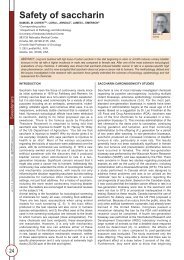
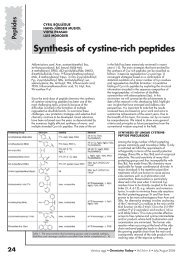
![Pietro Delogu [modalità compatibilità]](https://img.yumpu.com/12255149/1/190x135/pietro-delogu-modalita-compatibilita.jpg?quality=85)
